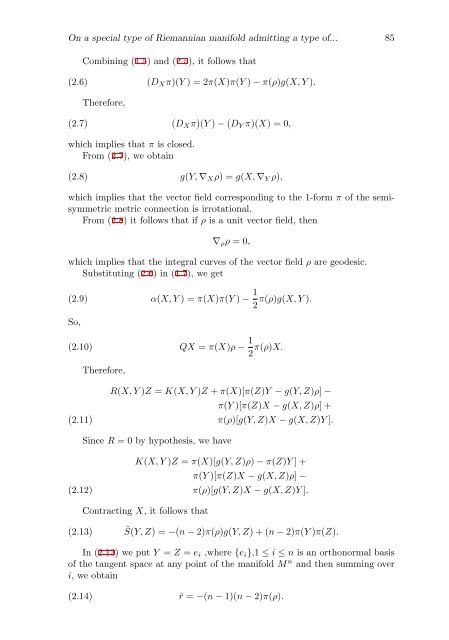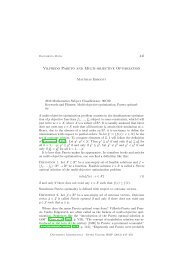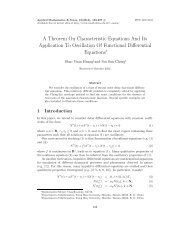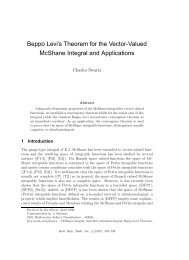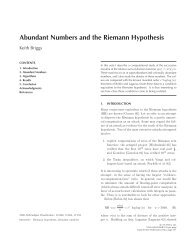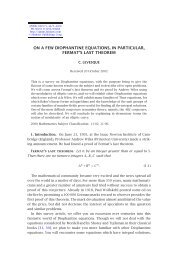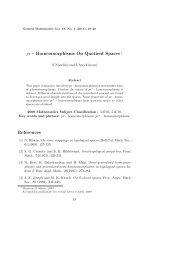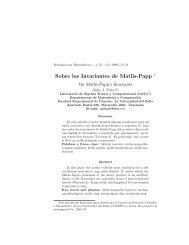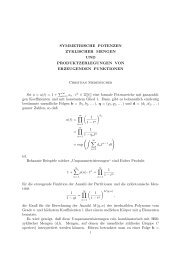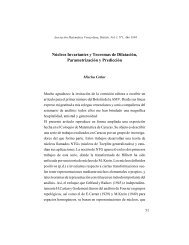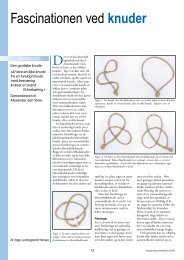On a special type of Riemannian manifold admitting a type of semi ...
On a special type of Riemannian manifold admitting a type of semi ...
On a special type of Riemannian manifold admitting a type of semi ...
Create successful ePaper yourself
Turn your PDF publications into a flip-book with our unique Google optimized e-Paper software.
<strong>On</strong> a <strong>special</strong> <strong>type</strong> <strong>of</strong> <strong>Riemannian</strong> <strong>manifold</strong> <strong>admitting</strong> a <strong>type</strong> <strong>of</strong>... 85<br />
Combining (1.5) and (2.5), it follows that<br />
(2.6) (D X π)(Y ) = 2π(X)π(Y ) − π(ρ)g(X, Y ).<br />
Therefore,<br />
(2.7) (D X π)(Y ) − (D Y π)(X) = 0,<br />
which implies that π is closed.<br />
From (2.7), we obtain<br />
(2.8) g(Y, ∇ X ρ) = g(X, ∇ Y ρ),<br />
which implies that the vector field corresponding to the 1-form π <strong>of</strong> the <strong>semi</strong>symmetric<br />
metric connection is irrotational.<br />
From (2.8) it follows that if ρ is a unit vector field, then<br />
∇ ρ ρ = 0,<br />
which implies that the integral curves <strong>of</strong> the vector field ρ are geodesic.<br />
Substituting (2.6) in (1.7), we get<br />
(2.9) α(X, Y ) = π(X)π(Y ) − 1 π(ρ)g(X, Y ).<br />
2<br />
So,<br />
(2.10) QX = π(X)ρ − 1 2 π(ρ)X.<br />
Therefore,<br />
(2.11)<br />
R(X, Y )Z = K(X, Y )Z + π(X)[π(Z)Y − g(Y, Z)ρ] −<br />
π(Y )[π(Z)X − g(X, Z)ρ] +<br />
π(ρ)[g(Y, Z)X − g(X, Z)Y ].<br />
Since R = 0 by hypothesis, we have<br />
(2.12)<br />
K(X, Y )Z = π(X)[g(Y, Z)ρ) − π(Z)Y ] +<br />
π(Y )[π(Z)X − g(X, Z)ρ] −<br />
π(ρ)[g(Y, Z)X − g(X, Z)Y ].<br />
Contracting X, it follows that<br />
(2.13) ˜S(Y, Z) = −(n − 2)π(ρ)g(Y, Z) + (n − 2)π(Y )π(Z).<br />
In (2.13) we put Y = Z = e i ,where {e i },1 ≤ i ≤ n is an orthonormal basis<br />
<strong>of</strong> the tangent space at any point <strong>of</strong> the <strong>manifold</strong> M n and then summing over<br />
i, we obtain<br />
(2.14) ˜r = −(n − 1)(n − 2)π(ρ).


